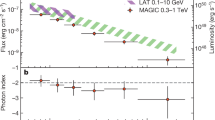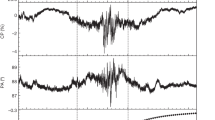Abstract
NEITHER the termination shock wave formed where the solar wind ceases to be supersonic, nor the slightly more distant heliopause, where the wind runs into the interstellar medium, have been directly observed, but estimates based on observed cosmic-ray modulations and on pressure balance between the two media1 suggest that they are 50–200AU from the Sun. We argue here that the well-known interplanetary radio emission of 2–in frequency2–4 istrapped in the electromagnetic cavity formed by the heliopause5,6, and furthermore that the fluctuating solar wind will cause the frequency of this trapped radiation to increase at a rate dependent on the geometry of the cavity. Applying this interpretation to the previously unexplained frequency drift, amounting to ˜1 kHzyr-1, of the 3–kHz burst4, we estimate an average heliopause distance of 60–100 AU.This agrees with recent data from Pioneer 10 and Voyager 2, suggesting that the termination shock is located at a distance of ˜50 AU, and implies that Voyager 1 may reach the shock in about 1993 and the heliopause as early as 1996.
This is a preview of subscription content, access via your institution
Access options
Subscribe to this journal
Receive 51 print issues and online access
$199.00 per year
only $3.90 per issue
Buy this article
- Purchase on Springer Link
- Instant access to full article PDF
Prices may be subject to local taxes which are calculated during checkout
Similar content being viewed by others
References
Jokipii, J. R. in Proc. XIXth ESLAB Symp. Les Diablerets (ed. Marsden, R. G.) 375–387 (Reidel Dordrecht, 1986).
Kurth, W. S., Gurnett, D. A., Scarf, F. L. & Poynter, R. L. Nature 312, 27–31 (1984).
Kurth, W. S., Gurnett, D. A. & Scarf, F. L. Adv. Space Res. 6, 379–383 (1986).
Kurth, W. S., Gurnett, D. A., Scarf, F. L. & Poynter, R. L. Geophys. Res. Lett. 14, 49–52 (1987).
Axford, W. I. Solar Phys. 100, 575–586 (1985).
Fahr, H. J., Neutsch, W., Grzedzielski, S., Macek, W. & Ratkiewicz-Landowska, R. Space Sci. Rev. 43, 329–381 (1986).
Barbosa, D. D. Astrophys. J. 243, 1076–1087 (1981).
McNutt, R. L. Geophys. Res. Lett. 15, 1307–1310 (1988).
Burlaga, L. F. Space Sci. Rev. 39, 255–316 (1984).
Gangopadhyay, P., Ogawa, H. S. & Judge, D. Astrophys. J. 336, 1012–1021 (1989).
Judge, D. L., Gangopadhyay, P. & Grzedzielski, S. in Proc. 1st COSPAR Colloq. Warsaw 1989 (eds Page, D. E. & Grzedzielski, S.) (Pergamon, in the press).
Grzedzielski, S. & Ziemkiewicz, J. Adv. Space Res. 9, 247–250 (1989).
Czechowski, A. & Grzedzielski, S. in Proc. 1st COSPAR Colloq. Warsaw 1989 (eds Page, D. E. & Grzedzielski, S.) (Pergamon, in the press).
Suess, S. T. & Dessler, A. J. Nature 317, 702–703 (1985).
Author information
Authors and Affiliations
Rights and permissions
About this article
Cite this article
Czechowski, A., Grzedzielski, S. Frequency drift of 3-kHz interplanetary radio emissions: evidence of Fermi accelerated trapped radiation in a small heliosphere?. Nature 344, 640–641 (1990). https://doi.org/10.1038/344640a0
Received:
Accepted:
Issue Date:
DOI: https://doi.org/10.1038/344640a0
This article is cited by
-
Radio emissions from the outer heliosphere
Space Science Reviews (1996)
-
Gasdynamic structure of the heliosphere: Theory and experiment
Fluid Dynamics (1993)
-
Physical reasons and consequences of a three-dimensionally structured heliosphere
Space Science Reviews (1991)
-
Sounding a small heliosphere
Nature (1990)
Comments
By submitting a comment you agree to abide by our Terms and Community Guidelines. If you find something abusive or that does not comply with our terms or guidelines please flag it as inappropriate.



